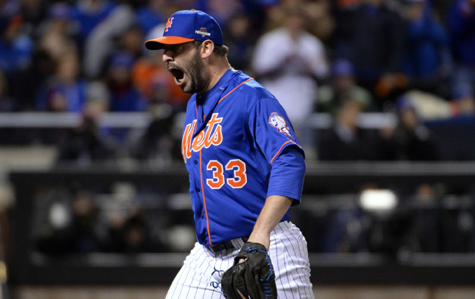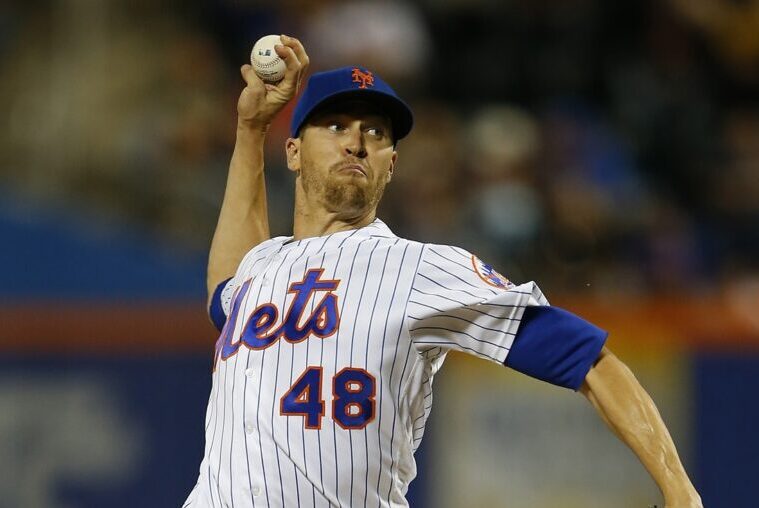
Matt Mancuso selects:
2015 Matt Harvey
Armed with one of the more deadly arsenals in the game, a mentality that matched up to 2019 Max Scherzer, and a nickname that defined him as a literal superhero, Matt Harvey’s the guy I want toeing the rubber.
While Jacob deGrom is more of a silent assassin, 2015 Harvey is the type of player you want in big games. A pitcher that can use the energy of the crowd effectively to enhance and define his performance.
There are plenty of examples of this occurrence littered throughout Harvey’s time with the Mets. The first eight innings of Game 5 of the World Series (anything beyond the eighth frame never happened, if you ask me).
Game 3 of the NLDS. The Harvey/Strasburg game. If there was anyone I would want toeing the rubber in a win-or-go-home game, it would be Matt Harvey.
With The Dark Knight on the mound and the crowd in the frenzy, the ceiling’s the limit.
And that’s not even mentioning his arsenal. At his best, Harvey’s repertoire consisted an upper-90s fastball, a nasty slider while mixing in a change-up and curveball.
That heater had devastating late life, befuddling hitters aplenty. Meanwhile, the slider was one of the better off-speed deliveries in the game, producing almost a 40% whiff rate.
His two other breaking pitches were no slouches of their own either, each inducing whiff rates greater than 30%.
Matt Harvey’s time with the Mets has seemingly come to a close, but his legacy will never be forgotten

Tim Ryder selects:
2019 Jacob deGrom
In a winner-take-all game, a manager wants his big dog out there (what up, Todd Frazier). In New York Mets history, there haven’t been many bigger pups than Jacob deGrom.
The two-time Cy Young Award winner began that reign in 2018 with his historic 1.70 ERA (1.99 FIP), 269-strikeout, 9.0 wins above replacement (FanGraphs) campaign.
DeGrom of 2018 would be a shoo-in for any sort of Game 7-type matchup, but it would also defeat the purpose of this column.
So for argument’s sake — literally — we’ll go with deGrom’s older, wiser, and just as impressive 2019 season.
Despite a slight, wholly palatable drop off in his running stats in 2019 (2.43 ERA, 2.67 FIP, 7.0 fWAR), the 31-year-old right-hander saw his peripheral metrics either stay at that elite level or actually get better.
DeGrom’s strikeouts per nine jumped marginally (11.25 K/9 from 11.16 in 2018) and kept his bases-on-balls to a minimum (1.94 BB/9).
His 29.7 percent hard-hit rate ranked third in baseball among all qualified pitchers (teammate Noah Syndergaard‘s 28.9% rate ranked second).
Let’s say whoever deGrom and the Mets are facing find themselves with runners on base. What — Jake worry? Never.
With runners in scoring position last year, the three-time All-Star and 2014 NL Rookie of the Year held hitters to a paltry .183/.274/.275 line.
With the bases loaded, those percentages dropped to .167/.154/.250.
His first two times through the batting order, deGrom racked up 193 strikeouts and 29 walks over 576 plate appearances last season.
Safe to say the Mets would be in good hands over the first five or six innings. Approaching the end of the line, though? No need to worry.
Once deGrom reaches 100 pitches, he kicks it up a notch to get the job done.
In 46 plate appearances after crossing the century mark last season, Jake struck out 15, walked three, and held hitters to a .167/.222/.333 line.
And if anyone was worried that deGrom couldn’t handle the big spots, they’d just need to look at his glowing 2.88 ERA over four postseason starts (29 strikeouts, eight walks).
If the Mets needed to win one game, 2019 Jacob deGrom would be my guy.
















